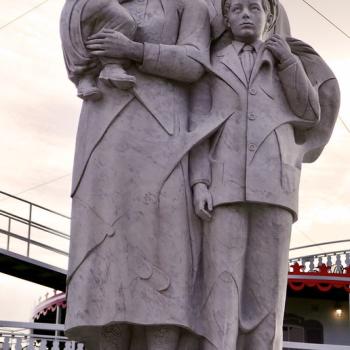Yet despite their fascinating content and moments of brilliance, I found the first half of the book to be somewhat disjointed, uneven, and more a collection of semi-related essays than complimentary book chapters. Because they were more topical in nature and covered overlapping chronologies, I found some sections repetitive and other sections underdeveloped. It was here where Brown was most often loose with his sources, relying on late reminiscences or sporadic records in order to argue for cultural tensions that may not have been as dominant as the book depicts.
These chapters also rely on some over-generalizations, like when Brown describes Smith as "an epic 'action hero' of death in the style of the ancients" similar to "a Heracles, a Beowulf, a Gilgamesh, and Odysseus," or when he states how "nineteenth-century readers would have found in the story of Lamoni scriptural confirmation of the power of the ambiguous status of the corpse"—claims that appear either hyperbolic enough to raise an eyebrow or go beyond the evidence the book presents. Further, this half of the book makes early Mormonism appear more homogeneous and consistent than what it likely was, a point that I will return to later. While there are still important lessons and interpretations found therein, these chapters suffer for acting closer to thematic explorations than a systematic examination.
The second half of the book, where Brown outlines Joseph Smith's theological response to the problem of death, is much more successful, and it is here that In Heaven as it Is on Earth provides its crucial contribution to Mormon Studies. Focusing on Joseph Smith's response to the grave, Brown argues that "everlasting communities," solemnized in the temple and designed to forge families and societies together for eternity, are central to Mormonism's conquest of death. "All the exegetical theology, metaphysical energy, and earnest perfectionism of Smith's temple system," Brown explains, "served the end of creating a sacerdotal heaven family that would be stronger than the caprice of death and the Protestant God."
Similar to the gregarious Joseph Smith of Richard Bushman's biography—at one point, Brown argues how the prophet "strongly preferred extinction to eternal loneliness" (168)—this book posits eternal unions as the organizational feature of LDS theology. More than just accurately reconstructing the theological worldview of Mormon Nauvoo, Brown's treatment skillfully outlines the attractiveness of the Latter-day Saints' "families are forever" doctrine that has comforted millions from 1842 until the present day.
While there is much in these chapters that could be highlighted, I found two sections exceptionally helpful. First was how Brown treated the relationship between LDS temple rituals and Masonry. Critics and apologists have long argued over whether Joseph Smith "stole" elements of Masonic rituals for his own temple endowment, with little effort to move beyond superficial similarities. Brown argues instead that it is not important where Smith received certain practices, but what he did with them. Positing that Smith "translated"—a process that will be the focus of Brown's next project—this book engages what Smith's use of Masonry reveals about his larger theological project.
Similarly insightful is Brown's section on plural marriage, a topic that has received lots of attention in Mormon history but has rarely received such a sophisticated theological examination that places the practice more fittingly within Smith's cosmology. Taken together, In Heaven as It is on Earth brilliantly outlines what it calls Smith's "sacerdotal genealogy," a practice in which "humanity could be interconnected in indissoluble bonds—the broad kinship group was the actual structure of heaven."
This does not mean the book's reconstruction of Joseph Smith's theology was completely persuasive, however. In an attempt to emphasize continuity in the Mormon prophet's thought from 1830 to his death, I came away not entirely convinced that Smith's thought was as consistent or internally coherent as Brown depicts. With continuity, Brown is less persuasive in arguing Smith's consistent belief in a physically embodied God and theosis; with coherency, I am hesitant toward the systematic ontology and domestic organization the book places on Smith.
While I agree that much of the previous scholarship on early Mormon thought has overstated the progress and inconsistency of Smith's development, and Brown's book should help push the pendulum more towards the center, the LDS prophet's scriptural texts and two decades worth of documents demonstrate enough of a learning curve and eclectic approach to elude the strict parameters of this study—not to mention the numerous theological trajectories different factions took following Smith's death demonstrate the inchoate nature of his teachings.



